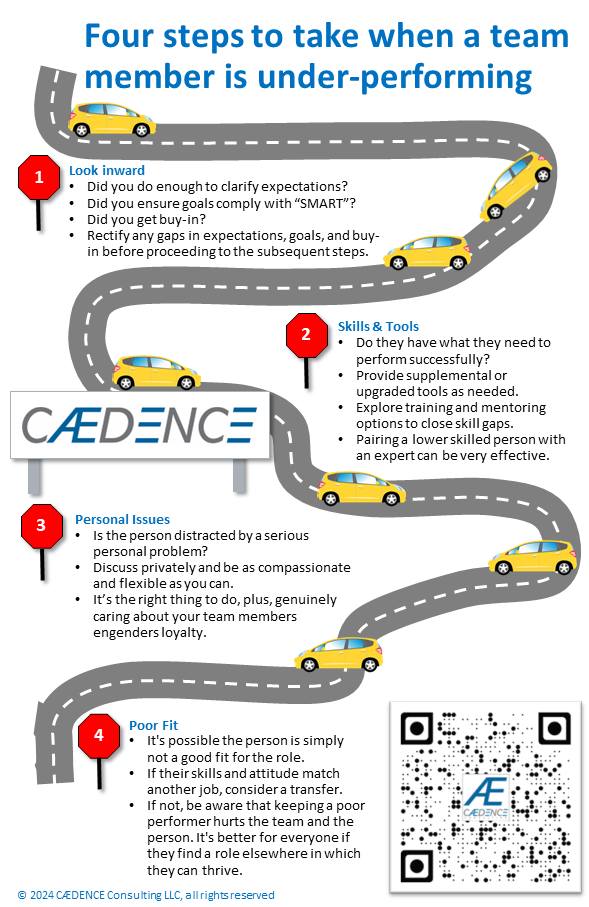What to do when a team member isn’t performing

Dealing with an underperforming team member is a “rite of passage” for any manager. Our 4-step approach will guide you through this challenge.
Consider the 4 likely reasons for low performance:
1) Expectations not understood or goals not clear
2) Skill gaps
3) Personal problems
4) Talent not suited for the role
1) When faced with an underperforming team member, we recommend first looking inward - did you do enough (a) to clarify the overall behavior expectations (taking initiative, following up, thinking creatively, etc.), and (b) to ensure the person's individual goals comply with all aspects of SMART (Specific, Measurable, Achievable yet Aggressive, Relevant, Time-bound & Tracked), and (c) to get buy-in from the team member? Rectify any gaps in expectations, goals, and buy-in before proceeding to the subsequent steps.
2) If expectations and goals are clear, but results are still not forthcoming, examine the person's skillset and available tools. Do they have what they need to perform successfully? If supplemental or upgraded tools are needed, provide them. If there are specific skill gaps, explore training and mentoring options. Pairing a lower skilled person with an expert can be very effective (but only if the expert is guiding/developing, not doing the work for the unskilled person).
3) If expectations & goals are clear and skills/tools are adequate, it's possible the person is distracted by a serious personal problem. Obviously, such issues should only be discussed privately. Be compassionate and be as flexible as you can. Perhaps some work could be shifted to another person temporarily, etc. It’s the right thing to do, plus, people who understand that you really care about them will be highly motivated to help you when things return to normal for them.
4) If expectations and goals are clear, skills/tools are adequate, and there is no personal problem, it's possible the person is simply not a good fit for the role. This does not mean they are a bad person, or a bad professional, just that their style does not work well in your company's system. In this case, you may need to take action to address the performance gap. If the person's skills and attitude match another job better, maybe an internal move could make sense. If the person would not likely be successful in another role, then you may have to formally put them on a performance improvement plan. In the end, keeping a poor performer hurts the team and hurts the person. It's better for everyone if they find a role elsewhere in which they can thrive.
Note: Addressing poor performance is a vital management activity. It's a skill that you should develop. Acting swiftly in these cases is recognized by senior leaders as a positive management trait. Mastering this skill is important to career development and being viewed as an effective leader.

Over the years we’ve been exposed to Six Sigma, Juran, Deming PDCA, 8D, Dale Carnegie, A3, Shainin, and more. Each technique works pretty well, and has been demonstrated many times in a wide variety of industries and circumstances. At the core they are all essentially the same!
Each approach relies on an underlying logical flow that goes like this: [a] make sure the problem is clearly defined; [b] be open to all sources of information; [c] vet the information for relevance and accuracy; [d] use the process of elimination to narrow down all possible causes to the most likely few; [e] prove which of the suspects is really the cause of the issue; [f] generate a number of potential solutions; [g] evaluate the effectiveness, feasibility and risk of the potential solutions; [h] implement the winning solution(s); and [i] take steps to make sure your solution(s) don’t unravel in the future.
The differences between the paradigms resides in supplementary steps and toolkits. For example, 8D contains the important “In









